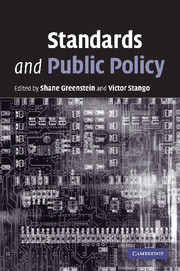Book contents
- Frontmatter
- Contents
- List of figures
- List of tables
- List of contributors
- Introduction
- 1 Standard setting in markets: the browser war
- 2 Competition through institutional form: the case of cluster tool standards
- 3 The economic realities of open standards: black, white, and many shades of gray
- 4 Coordination costs and standard setting: lessons from 56K modems
- 5 Promoting e-business through vertical IS standards: lessons from the US home mortgage industry
- 6 Intellectual property and standardization committee participation in the US modem industry
- 7 Manipulating interface standards as an anticompetitive strategy
- 8 Delay and de jure standardization: exploring the slowdown in Internet standards development
- 9 Standardization: a failing paradigm
- 10 Standards battles and public policy
- 11 Switching to digital television: business and public policy issues
- 12 Should competition policy favor compatibility?
- Index
- References
7 - Manipulating interface standards as an anticompetitive strategy
Published online by Cambridge University Press: 22 September 2009
- Frontmatter
- Contents
- List of figures
- List of tables
- List of contributors
- Introduction
- 1 Standard setting in markets: the browser war
- 2 Competition through institutional form: the case of cluster tool standards
- 3 The economic realities of open standards: black, white, and many shades of gray
- 4 Coordination costs and standard setting: lessons from 56K modems
- 5 Promoting e-business through vertical IS standards: lessons from the US home mortgage industry
- 6 Intellectual property and standardization committee participation in the US modem industry
- 7 Manipulating interface standards as an anticompetitive strategy
- 8 Delay and de jure standardization: exploring the slowdown in Internet standards development
- 9 Standardization: a failing paradigm
- 10 Standards battles and public policy
- 11 Switching to digital television: business and public policy issues
- 12 Should competition policy favor compatibility?
- Index
- References
Summary
Abstract
The creation of interface standards enables competition at the level of components, rather than in complete systems, and consumers often benefit from component competition. Nevertheless, the standard-setting process can be manipulated to achieve anticompetitive ends. The authors consider the conditions under which a standards consortium could impose anticompetitive burdens on the market and examine several strategies such a consortium might employ to achieve anticompetitive objectives. They present a new strategy – one-way interface standards – and discuss the conditions under which it can be anticompetitive.
Introduction
Complementary devices in a complex technological system must communicate through interfaces to interoperate successfully. In systems that involve communications and computing functions, interfaces are connections through which signals pass. The devices on both sides of an interface (e.g., the microprocessors and a disk drive, or the PBX [that is, the private branch exchange] and the central office switch) must be designed so that they make the correct physical connection, send the correct signals to each other, and correctly interpret the signals received. We refer to the formal physical and signaling details as the interface specification.
Communications and computing functions are featured in a much wider variety of systems than those we think of as primarily telecommunications or computers. For example, automobiles have sophisticated controller systems in which multiple components communicate with each other. Medical devices often perform sophisticated computation. At the least, our analysis applies to any system through which information flows through electrical, photonic, or other electromagnetic signaling.
Information
- Type
- Chapter
- Information
- Standards and Public Policy , pp. 231 - 259Publisher: Cambridge University PressPrint publication year: 2006
References
Accessibility standard: Unknown
Why this information is here
This section outlines the accessibility features of this content - including support for screen readers, full keyboard navigation and high-contrast display options. This may not be relevant for you.Accessibility Information
- 2
- Cited by
